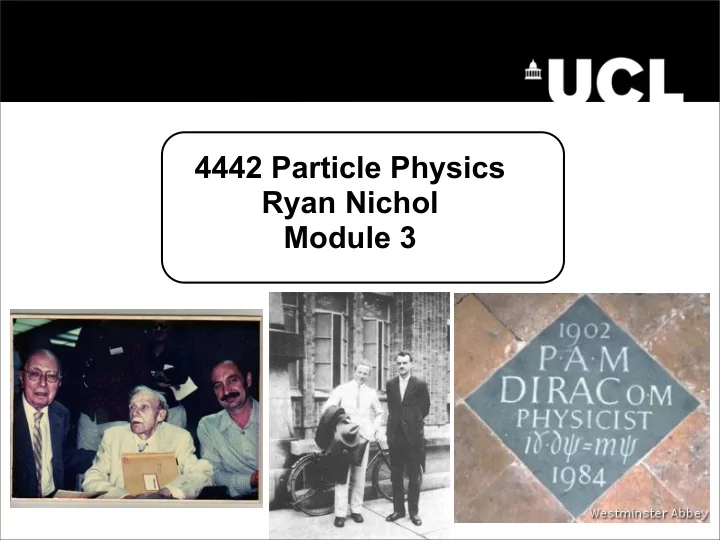

4442 Particle Physics Ryan Nichol Module 3
The Dirac Equation • Time to move on from toy theories • Need a proper theoretical description – Spin 1/2 matter particles (Fermions) – Interacting via spin 1 force particles (Bosons) – Must be relativistic • Essentially need to find a replacement for the non- relativistic Schrödinger equation which originates from: p 2 H Ψ = � 1 i @ Ψ @ t = ˆ 2 m r 2 Ψ + V Ψ 2 m + V = E • using the standard quantum mechanics operators for energy and momentum p = � i ~ ˆ r ˆ P µ = i @ µ E = + i @ ˆ 2 @ t
The Dirac Equation • The Klein-Gordon equation @ µ @ µ Ψ + m 2 Ψ = 0 • is a relativistic : E 2 = p 2 + m 2 : wave equation but there is a troublesome negative probability density solution (arising from ). p 2 + m 2 p E = � • Dirac managed to produce an equation valid in both the relativistic and non-relativistic regimes which also has a “natural” interpretation of the negative energy solutions - he invented the notion of anti-particles (with positive probability density solutions) which were then experimentally verified a year later. • Derivation of Dirac equation rests on the introduction of 2x2 (Dirac)-matrices since matrices can have the property that AB + BA = 0 whereas numbers are commutative and this allowed : positive density solutions since the equation contained no E 2 (- ∂ 2 ψ / ∂ t 2 ) terms and for the solutions to satisfy E 2 = p 2 + m 2 . 3
Derivation of the Dirac Equation Dirac gamma Matrices satisfy : And The Dirac equation is written as : or The Dirac Hamiltonian is (derivation in problem sheet) 4
Dirac Gamma Matrices p • Pauli spin matrices are 2x2 matrices ✓ 0 ◆ ✓ 0 ◆ ✓ 1 ◆ 1 − i 0 σ 1 = , σ 2 = , σ 3 = i 1 0 0 0 − 1 • Dirac gamma matrices are 4x4 matrices ✓ ◆ ✓ ◆ ✓ ◆ 1 0 0 0 1 γ 0 = , γ i = , γ 5 = σ i 0 − 1 0 1 0 − σ i • e.g 0 1 − i 0 0 0 i 0 0 0 γ 2 = B C B C i 0 0 0 @ A − i 0 0 0 5
B C @ A Useful Operators − • Dirac Hamiltonian ✓ m ◆ ~ � · ~ p ˆ H = ~ � · ~ p − m • Helicity ✓ ~ ◆ h = 1 � · ˆ p 0 ✓ ˆ ~ � · ˆ p 0 2 · • Spin ✓ ◆ S = 1 ~ � 0 ✓ ◆ ~ ~ ~ Σ = Σ ~ � 0 2 • Total angular momentum L + 1 J = ~ ~ ~ Σ 6 2
Solutions for particles at rest ( � µ @ µ − m ) Ψ = 0 • Dirac equation: • For a particle at rest: @ Ψ @ x = @ Ψ @ y = @ Ψ p = 0 ~ @ z = 0 • Therefore: i � 0 @ Ψ @ t − m Ψ = 0 ✓ ◆ Ψ 1 Ψ A = ◆ ✓ ∂ Ψ A Ψ 2 ✓ ◆ ✓ ◆ 1 0 Ψ A ∂ t = − im ∂ Ψ B 0 − 1 Ψ B ✓ ◆ Ψ 3 ∂ t ✓ ◆ Ψ B = Ψ 4 • And: @ Ψ A Ψ A ( t ) = Ψ A (0) e − imt = − im Ψ A @ t @ Ψ B Ψ B ( t ) = Ψ B (0) e + imt = + im Ψ B @ t 7
Solutions The solutions of the Dirac equation : are known as Dirac spinors. And can be expressed in terms of 2-spinors: χ 1 , χ 2 The “anti-particle” solutions : There are four independent solutions to the Dirac equation: two “particle” and two “anti-particle” solutions. Each describes (anti-)particles with mass and spin ½ e.g. quarks and electrons, in two helicity states. Derivation of solutions ** 8
Interpretation • Dirac’s Interpretation of negative energy solutions • If the -ve energy solution where an electron then we could get the situation where a +ve energy electron could interact with a photon to reduce it’s energy to be the more naturally preferred (and allowable by the Dirac eqn) -ve energy and this is not observed i.e. the negative energy solutions cannot be electrons. • Vacuum is a sea of -ve energy electrons. If we create a “hole” in the sea e.g. by hitting one of the -ve E electrons with a photon of E > 2me then the sea effectively increases in charge by +1, and becomes more positive in energy - our “hole” thus looks like a +ve E particle of +ve charge with the mass of an electron. This hole can be identified as a real particle - the positron with opposite charge, momentum, spin and energy to the original -ve E electron eigenstate but the same mass. • Shares many similarities with the discussion of holes in “Fermi seas” of semiconductors in condensed matter physics. • Discussion is actually more complex since we need to introduce Quantum Field Theory operators for particle creation/annihilation …… 9
Next Module • The continuity equation • “interaction currents” in terms of gamma matrices • Lagrangian formalism • The addition of EM interactions (Maxwell’s equations) into the Dirac equation i.e. a real theory – Quantum ElectroDynamics (QED) 10
Recommend
More recommend